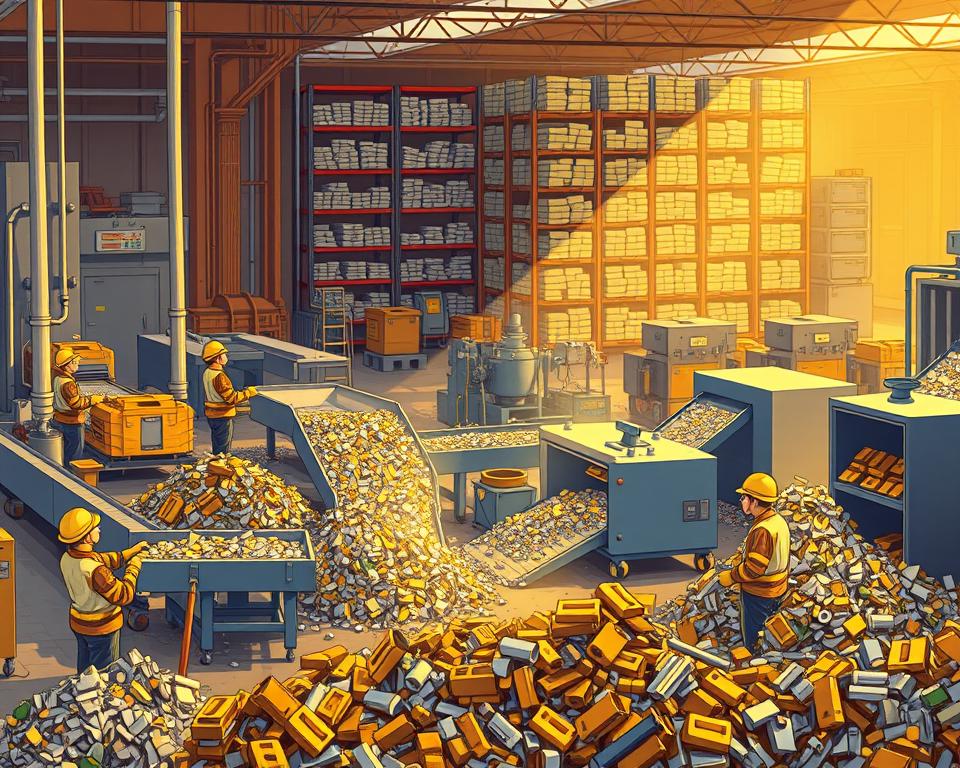Sustainable Precious Metal Recovery Guide
More than $60 billion in precious metals end up in e-waste every year—did you realize that? That eye-opening statistic shows how important recycling these metals really is. Recycling these metals benefits both the economy and the planet. Reclaiming gold, silver, platinum, and palladium helps lower pollution and preserve what’s left of our natural resources.
Companies like Dongsheng Metal Trading are leading the charge towards sustainability. They guarantee that valuable metals return to use instead of filling dumps. This precious metals recycling approach is key to eco-friendly recycling and sustainable practices.
Main Insights
- Each year, e-waste discards over $60 billion in precious metals.
- Recovering these metals cuts eco-impact and preserves resources.
- Key precious metals are gold, silver, platinum, and palladium.
- Sustainable development depends on eco-friendly recycling.
- Recycling experts like Dongsheng Metal Trading lead the industry.
Exploring Precious Metals and Their Worth
Naturally scarce metallic elements called precious metals draw interest from industries and investors. Gold, silver, platinum, and palladium stand out for their distinct qualities. They offer conductivity, resist corrosion, and occur in limited supply. Extracting and refining them uses up huge resources, so recycling becomes critical.

Intrinsic qualities and demand in the marketplace determine precious metals’ worth. Recycling precious metals plays a critical role in sustaining the supply chain. It also reduces environmental impacts associated with mining activities. Through exhaustive recycling processes, these metals can be restored to their original state. That process conserves scarce materials and boosts the economy.
Defining Precious Metals
Precious metals possess unique characteristics that make them desirable for a variety of applications. Their rarity and intrinsic properties are foundational to their economic significance. Key examples include:
- Au: Admired for its luster and low corrosion.
- Silver: Known for flexible uses and excellent conductivity.
- Platinum: Celebrated for its durability and catalytic properties.
- Palladium: Gaining traction in cars and electronics.
Reasons to Recycle Precious Metals
The practice of recycling precious metals has emerged as a vital component for sustainability. It preserves resources and lessens the environmental cost of mining. Key benefits include:
- Lessening of habitat destruction from mining.
- Using far less energy than fresh extraction.
- Feeding materials back into the production loop.
- Economic upside from extracting high-value resources.
Why Precious Metal Recycling Matters
Metal recycling brings both green and economic gains. Highlighting these advantages is key to reducing our ecological footprint. Additionally, it fuels market growth and resilience.
Eco Advantages
Green gains from metal recycling are huge. Retrieving metals from scrap and electronics reduces landfill load. This reduces the need for new mining, conserving natural resources.
This approach minimizes the harmful effects of mining, such as habitat destruction and pollution. Focusing on recycling precious metals helps us strive for a more sustainable future.
Economic Advantages
Financial perks of recycling are just as strong. Recycling precious metals can lower manufacturing costs. It lets businesses choose reclaimed over freshly mined metals.
It spawns jobs in recovery plants and steadies markets as recycled-metal demand rises. By leveraging these economic advantages, businesses can improve their profitability. They also contribute to a greener economy.
The Precious Metal Recycling Process
Recovering precious metals involves multiple steps for peak efficiency. It starts with collecting metals from various sources like discarded electronics, jewelry, and industrial scraps. They are sorted, decontaminated, and analyzed to gauge composition and value.
The Precious Metal Recycling Process
This systematic approach is vital for effective metal recovery. Each step is designed to optimize the yield of precious metals. Sorting separates metals by type and purity. Cleaning strips away impurities that impede extraction. Analysis identifies the concentration of precious metals, guiding the choice of recycling techniques.
Metal Separation Techniques
High-tech methods are used to maximize metal retrieval. One method, thermal reduction, leverages heat to separate metals from base materials. Smelting and chemical baths extract and purify metals. Firms such as Dongsheng Metal Trading apply these techniques to raise recovery and profits.
Recyclable Precious Metals
Scrap recovery benefits both Earth and economy. A host of precious metals are recyclable, aiding markets and ecosystems. Knowing which metals are recyclable helps individuals and firms.
Gold, Silver, and Platinum
Gold, silver, and platinum are well-known precious metals. They appear in jewelry, coinage, and industrial components. Gold’s high price and use make it a prime recycling target. Silver recovery matters too, thanks to its role in imaging, tech, and solar.
Platinum, though less common, is valuable, mainly in catalytic converters.
Electronics Precious Metals
E-waste metals present special recovery opportunities. Gadgets—from phones to laptops—house palladium, indium, and more. Reclaiming them cuts e-waste and recovers key resources.
It’s crucial to recover these electronic metals. Businesses work to reduce scrap and upscale resource recovery.
Industries that Benefit from Precious Metal Recycling
Metal recovery underpins major sectors by supplying reclaimed resources sustainably. The electronics industry, with its frequent use of precious metals in devices, benefits greatly. The aerospace and medical fields use precious metals in essential applications. Examining industry recovery uncovers eco- and economic advantages.
E-Waste Sector
The electronics industry leads in precious metal recycling due to the abundance of valuable metals in devices like smartphones and computers. Rapid technological advancements have led to a significant increase in electronic waste. Hence, recovering metals like gold, silver, and palladium is crucial. That saves resources and cuts mining carbon footprints.
Firms ramp up recycling to hit sustainability targets. This shift supports the ongoing need for resource conservation and environmental protection.
Aerospace and Medical Equipment
Recycling precious metals matters for aerospace and healthcare, given their reliance on them. Alloys prized for strength and anti-corrosion make up flight and medical components. Recycling these metals can significantly lower material costs and comply with environmental regulations.
They recognize that recycling offsets material scarcity. And it improves operations, making metal recycling a smart green tactic.
How to Choose a Metal Recycler
Finding trustworthy precious metal recycling companies is key to recycling effectively. It’s wise to ask important questions to understand their operations. Knowing their pricing and processing methods can greatly affect your experience. Service comparisons help you pick the best recycler.
Questions to Ask Recycling Companies
- Can you share your precious-metal recovery accreditations?
- How do you process various precious metals?
- What yields can you deliver for gold, silver, and more?
- Can you detail your fees and any surcharges?
- Can you share feedback from past customers?
Comparing Prices and Services
When searching for a recycler, it’s vital to compare different companies based on their services. Create a table to compare key factors such as:
| Company Name | Recovery Rate (%) | Processing Fee ($) | Turnaround Time (Days) |
|---|---|---|---|
| Recycling Co. A | 95 | 50 | 7 |
| Recycling Co. B | 90 | 45 | 5 |
| Recycling Co. C | 92 | 55 | 10 |
Side-by-side comparisons help pinpoint the ideal recycler. That way, you maximize returns and maintain quality.
Precious Metal Recycling: Your Eco-Friendly Guide
Understanding how recyclers operate is key for those interested in precious metal recycling. These experts manage the entire process, from collection to processing. That approach drives top efficiency and returns.
Recycler Operations
Advanced workflows—assay, separation, smelting—unlock metal value. First, they gather scrap from multiple origins. Afterwards, they apply refined techniques to isolate each metal. Next, they refine these metals to extract precious elements like gold, silver, and platinum.
That workflow both boosts recovery and promotes green methods. It’s a critical step towards sustainable development.
Choosing the Right Recycler for Your Needs
When picking a recycler, several factors are important. Begin by checking their green credentials. A focus on sustainability is non-negotiable. Also, examine if they handle everything or only certain stages.
Cost is equally important. Request estimates from multiple firms. Experts like Dongsheng Metal Trading provide industry-specific offerings. They stand out as dependable recyclers.
Pick the Right Facility
Recovery facilities are central to green waste solutions. Multiple types of facilities handle various recycling demands. Understanding these facilities improves access to recyclers and their services. That supports firms and ecosystems alike.
Types of Facilities Available
Metal recycling facilities vary widely in their operations. Some yards recover gold and silver; others accept all metal waste. Common examples include:
- Metal Scrap Yards: Typically focus on general metal waste, including ferrous and non-ferrous metals.
- Specialized firms recover gold, silver, and platinum with advanced refining.
- Electronics recyclers extract metals from old gadgets.
Choosing Facility Locations
Easy access to facilities boosts recovery efficiency. Businesses must consider the logistics of transporting materials. Here are some factors that influence access:
| Factor | Description |
|---|---|
| Distance | Nearby recyclers reduce haul time and expense. |
| Networking | Strong ties with local centers streamline recovery. |
| Services Offered | Awareness of service menus aids in picking the right center. |
Ultimately, facility type and access shape recycling success.
E-Waste Recycling & Metal Recovery
Discarded electronics threaten the environment. Many e-waste items hold recoverable precious metals. This highlights the importance of seeing e-waste as a valuable resource.
Electronic Precious Metals
Many electronic devices hold small amounts of precious metals like gold, silver, and palladium. You’ll find them in components such as:
- Circuit boards
- Connectors and ports
- Capacitors and resistors
- Battery terminals
From phones to TVs, electronics pack precious metals. By recycling, we retrieve and reuse these valuable elements.
The Importance of E-Waste Recycling
E-waste recycling is vital for both environmental protection and resource recovery. It trims dump loads and conserves raw materials. Key perks include:
- It cuts ecological hazards from poor e-waste handling
- It reduces CO₂ output via green recycling methods
- It bolsters circular models by returning scrap to production
Encouraging electronic recycling promotes sustainable resource management. It lays the groundwork for a greener future.
The Future of Precious Metal Recycling
Metal recycling is evolving, spurred by tech advances and green initiatives. As the need to conserve resources grows, major players in recycling are adapting. By integrating novel processes, they pave the way forward.
Green Recycling Trends
Modern green recycling strives to cut waste and eco-damage. Firms now use bio-packaging and low-energy methods. These changes align with global sustainability objectives, pushing industries towards more responsible and planet-friendly behaviors.
Innovations in Precious Metal Recovery
Advances in recovery techniques are key to improving precious metal recycling efficiency. Robotic sorting and chemical extraction raise recovery. They boost recovery and cut environmental costs—a leap for metal recycling.
Starting a Precious Metal Recycling Venture
Launching a metal recovery firm requires careful strategy and market insight. Leaders should map out steps, secure compliance, and set firm roots. Key tasks include market studies and pinpointing customer segments. Securing licenses and legal compliance is crucial for long-term viability.
Steps to Establishing a Business
Setting up a precious metal recycling venture requires several essential steps:
- Conduct market research to understand needs and rivals.
- Create a comprehensive plan with objectives and tactics.
- Purchase the right gear for your recycling operations.
- Obtain capital via loans or investors.
- Obtain vital permits and licenses for legal operation.
- Launch marketing to attract clientele.
Regulatory & Certification Needs
Understanding legal aspects when starting a precious metal recycling business is critical. Meeting environmental rules protects your operation and the planet. Key considerations include:
- Getting licensed by appropriate agencies.
- Complying with local, state, and federal regulations on waste disposal and recycling.
- Training staff in safety protocols and best practices.
The Bottom Line
Precious metal recycling is essential for preserving natural resources and improving environmental health. It empowers all of us to reduce environmental harm from waste. The recovered metals reduce mining needs and boost the economy by creating jobs in recycling.
Metal recovery delivers both eco and economic upsides. Teaming with Dongsheng Metal Trading secures sustainable methods. This collaboration strengthens the circular economy, benefiting both recyclers and consumers.
A sustainable tomorrow hinges on our joint metal-recycling efforts. Increased awareness builds a culture of green consumption and care. Embracing these steps helps today and protects tomorrow’s world.

